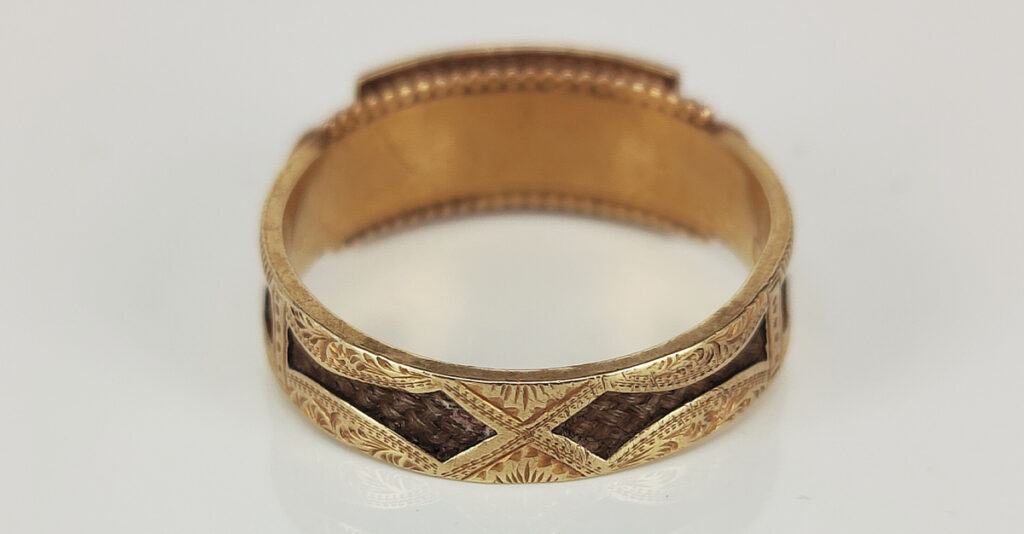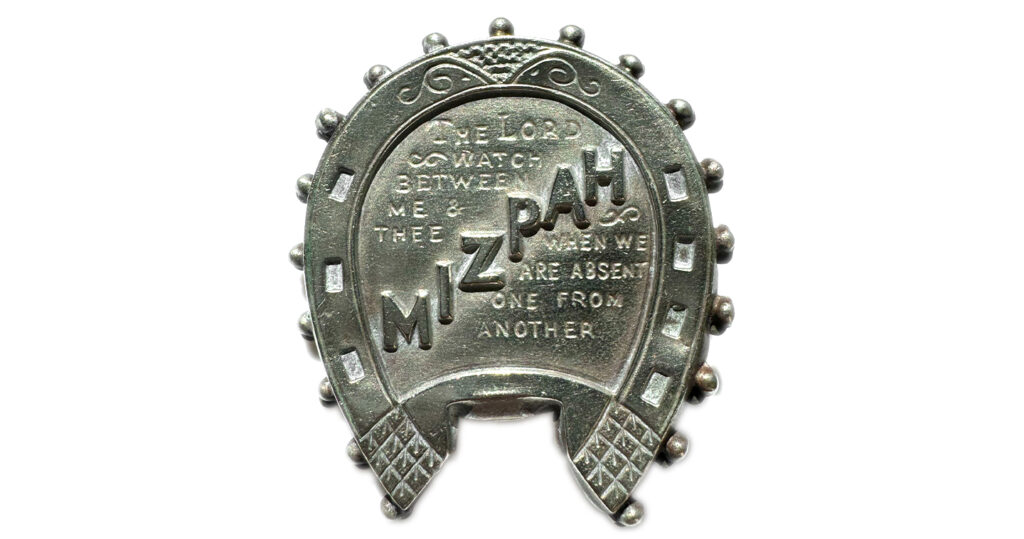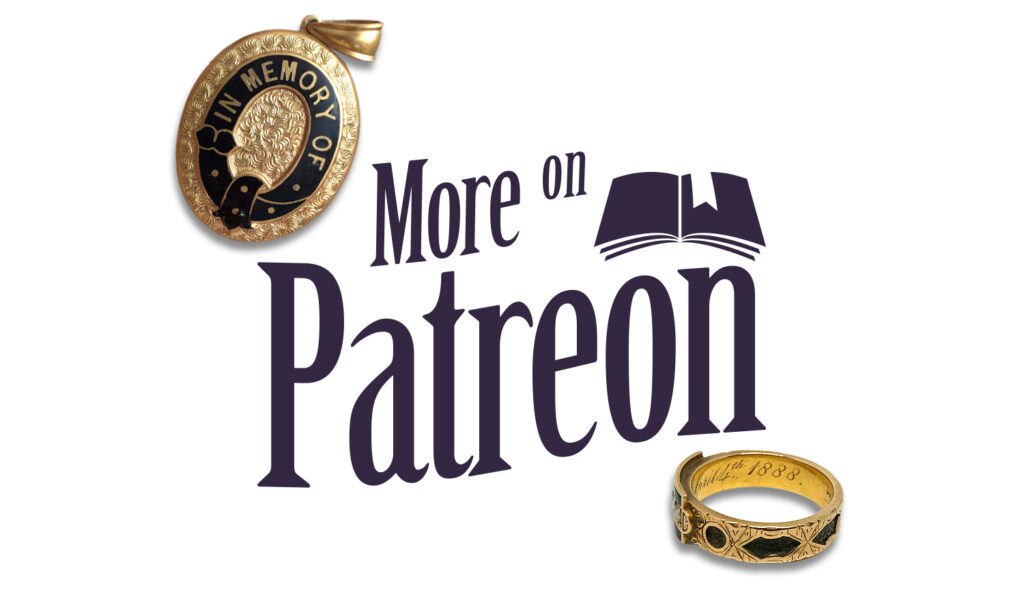Human Hair and Business in the 19th Century

Jewellery sold in stores was sourced from a variety of gold and silversmiths, but it was another kind of craftsperson who was integral to the mourning jewellery industry: hair weavers. Hair weaving was highly competitive during the 19th century and the weavers relied on their own skill level to order to promote their businesses.
The volume of hair artists/weavers fluctuated during the 19th century and by the mid 19th century, several businesses had become highly successful in their own practice. In the following newspaper classifieds from April 23rd, 1864, the Illustrated London News shows the fierce competition between four of these weavers:
HAIR JEWELLERY, – ARTIST IN HAIR.
DEWDNEY begs to inform Ladies and Gentlemen that he beautifully makes, and elegantly mounts in Gold Hair Bracelet, Chains, Brooches, Rings, Pins, Studs, &c, and forwards the same at about one half the usual charge. A beautiful collection of specimens, handsomely mounted, kept for inspection. An illustrated book sent post-free. – Dewdney, 172 Fenchurch-street, London.
A. FORRER, HAIR JEWELLER to the QUEEN, 2 Hannover-street, Hannover-square
HAIR JEWELS. – Illustrated Price-lists sent free by post by B. LEE, 41, Rathbone-place, London,. W. Quality and workmanship prove himself the cheapest manufacturer in England.
HAIR JEWELLER. – G. HOOPER, Artist in Hair, Solid Gold Lockets for Hair, from 5s, each ; Hair Rings, from 6s. 6d. ; Hair Chains, from 12s each &c. Illustrated Catalogues sent free. 213, Regent-street, London.
These advertisements are clustered together in the newspaper, showing just how the wording and offering of a business attempted to differentiate offerings amongst a highly competitive city. Hooper is the only hair artist to offer cost, which ranged from 5 to 12 shillings. It is Dewdney who promotes his business at the highest level, with superlatives such as ‘beautiful’, ‘elegant’ and ‘handsome’. Lee promotes himself as ‘the cheapest manufacturer’ in England, while the bold statement of Forrer is clear, that he is the ‘hair jeweller to the Queen’.
Commerce was primarily the factor in these advertisements, with the promotion of post-free catalogues on request to enhance the sales experience. In the same way that the Mourning Warehouses such as Jay’s would promote ‘inexpensive mourning’, the sentimentality of a loved one’s hair now had a cost associated with it.
REID AND SONS, GOLDSMITHS AND JEWELLERS TO THE QUEEN, MAKE and MOUNT in GOLD every description of SOUVENIR IN HAIR
HAIR BRACELETS Gold-mounted, from 5s 0d upwards
HAIR BROOCHES Do. from 10s 0d upwards
HAIR CHAINS Do. from 7s 0d upwards
HAIR RINGS Do. from 4s 6d upwards
HAIR PINS Do. from 15s 0d upwards
41, Grey Street, Newcastle-upon-Tyne.
For the cost of 5 shillings, hair could be given and woven into an artefact or accessory. The loved one may be living or deceased, as hair weaving was not exclusive to mourning. It was an affordable, sentimental material that was popularised from royalty down. For the hair weavers and artists, there needed to be quality assurance in the weaving of the hair to ensure that the hair was actually that of the loved one. Colour-matching was a skill that involved matching hair samples of loved ones to that of hair sold internationally. To fund their convents, nuns would grow, cut and sell their hair for weaving. Hair was an expensive commodity, not only in the United Kingdom, but France; an 1871 article in St. Neots Chronicle and Advertiser states “…the price of human hair in France was only about eight francs the kilo. The enormous increase in the value of the article which has since that time taken place begun with the Empire. Between 1852 and 1863 the price ranged from sixteen to twenty francs the kilo; but when, in the seven following years… the rate per kilo, which was quoted forty francs in 1866, was no less than one hundred and five francs in 1871.” St. Neots Chronicle and Advertiser – Saturday 27 February 1875
Advertising as a value proposition was utilised in marketing material, as can be seen in the Northern Whig from 1881:
PRIZE MEDAL HAIR JEWELLERY. D. S. HENDERSON & CO., ARTISTS IN HAIR, 18, CASTLE PLACE,
HAVING been engaged for upwards of twelve years, both in this country and the sister island, in the manufacture of every description of Hair Work, and having studied the art both in London and on the Continent, and possessing every facility for the execution of orders, they can safely guarantee that any work leaving their Establishment, shall be of the highest character and of the best workmanship hitherto attained in this branch of art.
On account of these advantages, anyone may possess a Souvenir of a dear and departed relative or friend, at a very small expense compared with what is generally charged at Hair Jewellery Establishments.
Every precaution is taken that the actual Hair sent is used – the greatest care being taken in the execution of every order — and any hair remaining over is returned.
About a quarter of an ounce of Hair is sufficient for a Bracelet, Chain, or Albert, and lees in proportion for smaller articles. — A Priced Catalogue will sent on receipt address.
Henderson’s statement of ‘every precaution is taken that the actual Hair sent is used – the greatest care being taken in the execution of every order — and any hair remaining over is returned’ solidifies the deception around the weavers not using the actual hair of the loved one. The statement around extra care shown by Henderson offers insights into the importance of driving sales for the hair artist.

Hair artists were closer to their subjects than the gold and silversmiths due to having to deal directly with a client. This required aligning the business as an affordable, trusted source, going well beyond what the regular jeweller would be required to do for the purpose of selling a mourning ring.
It was of the utmost importance that hair artists also maintained quality in their practice. Hair is shown in the advertisements as being an affordable material to use for jewellery, so it would be easy to simply market the cost of hair as the only sales point. Competition made the hair artistry business focus on the quality of the work and the credentials of the hair artist. Focusing on the jeweller, how they branded themselves, the work and the cost is paramount to understanding how and why a customer would entrust their loved one’s memory with the artist.
Sarah Beth Sparks passed away on the 1st of March, 1841, aged 16. Her hair was taken to Antoni Forrer to be woven into a bow shape with the centre bound with gold wire and trimmed with gold tassels. Forrer’s attention to detail in the brooch is of the highest quality. There is a very open weave to the piece, adding to its delicacy.
Antoni Forrer was a Swiss jeweller from Winterthur, who moved through several locations in London, being 93 Oxford Street, London in 1835-36, 136 Regent Street, in 1840-60, 32 Baker Street in 1861-63, 2 Hanover Street in 1864-75, 128 Oxford Street in 1876-79 and 286 Regent Street in 1880-82. He passed away at the age of 89 in 1889, leaving behind a successful business.
“ALL KINDS OF ORNAMENTS IN HAIR VIZ, NECKLACES, CROSSES, EARRINGS &c
A. FORRER
artiste en cheveux
136 Regent Street London
– Box of Sarah Beth Sparks, Forrer.
Within the garter symbol, Forrer merges his own brand together with the royal coat of arms, that he proudly advertises in publications, as he is ‘by appointment to the Queen.’ This original box is an insight into the artefacts that are used to market the jewel beyond regular print advertising. A box would be carried and stored with such a precious element, in this case the hair of Sarah Beth Sparks and seen every time the brooch was revisited. It is of note that Forrer put so much branding into his products, which is hardly surprising, considering the competition of hair artists during the 19th century. At one point in 1857, there was a clear division between Forrer and Charles Packer, who would later trade as Charles Packer & Co until c.1932, as can be seen in the following advertisement from the Illustrated London News:
ANTOINI FORRER, ARTIST in HAIR and JEWELLER to the QUEEN, by appointment, 24 Baker-street, Portman-square (opposite the Bazaar).
N.B. Antoni Forrer has no connection whatever with his late establishment at 136, Regent-street.
CHARLES PACKER (late Anotoni Forrer), Artist in Hair to the QUEEN by appointment. Hair Jewellery Department, 136 Regent-street. Foreign and fancy ditto, 78 Regent-street. Jet and Mourning ditto, 76 Regent-street.
Note how Packer is utilising the Forrer brand to promote their business, as he is the skilled artisan. For the following year, Charles Packer would continue to advertise the Forrer brand, while Forrer would attest his separation from his ‘late establishment’. Disassociation between the businesses showsPacker as the ‘mart’, or mass retailer, in this case, with an abundance of a variety of products, including a ‘hair jewellery department’, which removes the individual personality of the hair business from the store. Forrer, as a small-scale artisan maintains his own name as his brand.

As in the cases of Lee and Henderson, the hair artist themself was required as a persona to allow marketing of their product. The personal nature of taking someone’s hair and weaving it into a jewel is precious, even if only ‘a quarter of an ounce of’ hair, it represented the last artefact of a loved one. Forrer’s use of his own brand was important at this time to entice new clientele, whereas the dehumanised department store feel of Packer’s business devalued the personal nature of the hair.
The ring featured in this article appears courtesy of Kalmar Antiques, who you can find on Instagram, Twitter and on their website.






